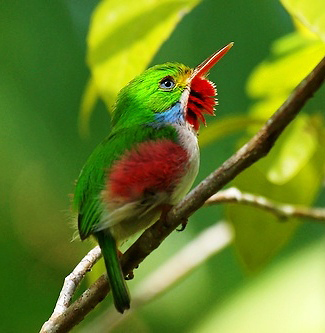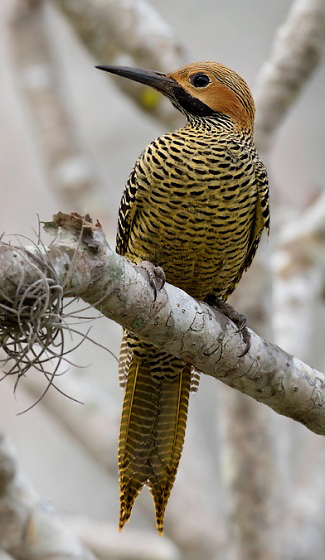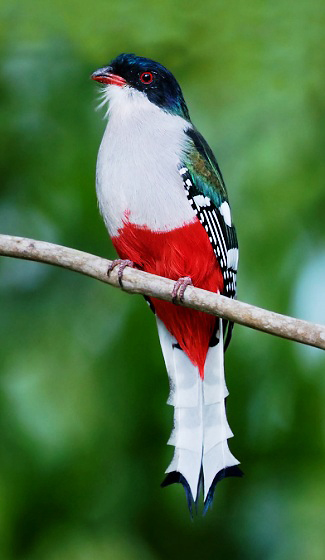

The brilliant Cuban Tody by Dave Irving.
- This big island is home to one of the world’s smallest bats, possibly the dinkiest frog and the smallest bird; the endemic Bee Hummingbird
- Which is one of 30 endemic birds on the island, also including the dazzling Cuban Tody and the beautiful Cuban Trogon, as well as Blue-headed Quail Dove and Fernandina's Flicker
- And there are plenty of wider Caribbean endemics, including Cuban Amazon, Grey-headed and Key West Quail Doves, Cuban
Emerald and Western Spindalis - Wintering warblers including Black-throated Blue, Cape May and Prairie
- And other spectacular birds such as American Flamingo, Magnificent Frigatebird, Brown Pelican and Northern Jacana
- The Bee Hummingbird is a mere 57 millimetres from the tip of its beak to the end of its tail; just 30 millimetres minus beak and tail. It is so small it is not as big as some bees and a lot smaller than many other insects. Even more remarkable is that it weighs about two grams, the same as a paper clip! This is believed to be the lowest possible weight for a warm-blooded animal, considerably lighter than the familiar Wren which weighs about ten grams. The tiny mites throb with life and are hyperactive but they usually stick to their favoured trees and with the help of local guides are usually easy to see. It is officially the world’s smallest bird, but the Little Woodstar, another hummingbird, which occurs from extreme south Colombia through Ecuador to far north Peru, is considered to be even smaller by some scientists.
- Another, alas unsuccessful, quest for the Ivory-billed Woodpecker took place in April 2016. Tim Gallagher was one of two people who gave the initial first-hand reports of an Ivory-billed Woodpecker in a bayou in Arkansas in 2004, reports which prompted a multi-million-dollar search for the lost woodpecker, led by the Cornell Lab of Ornithology. Several follow-up sightings and a blurry video were the results, but when the team failed to find indisputable evidence interest waned. However, while most have given up hope of the woodpecker not being extinct, Tim Gallagher has not and in April 2016 he and Dutch ornithologist Martjan Lammertink (who made two intensive searches in Cuba in 1991 and 1993 but didn’t find any birds) searched Alejandro de Humboldt National Park in far east Cuba for a week. It was there, four years after the last confirmed North American record in north-eastern Louisiana in 1944, that John Dennis and Davis Crompton photographed a nesting pair in 1948, and George and Nancy Lamb located six pairs in 1956. In 1959 the Cuban revolutionaries, who had been fighting government forces for several years, finally overthrew the Batista Regime and took over Cuba, and very little news of the birds came out of the country until 1986 when Lester Short and his colleagues at the American Museum of Natural History announced seeing the woodpeckers again, but then the trail went cold and the last sighting in Cuba was in 1987.

There are a lot of rather spectacular endemic birds on the island of Cuba, not least the Blue-headed Quail Dove. This fine image was captured at Bermejas near Zapata by Dubi Shapiro.
Best Birds and other wildlife in Cuba
Birds
The species lists below are for the northern winter.
Endemics 30 Blue-headed Quail-dove, Grey-headed Quail-dove, Cuban (Greater Antillean) Nightjar, Bee Hummingbird, Cuban (Greater) Lizard-cuckoo, Zapata Rail (very rarely observed), Cuban Pygmy-owl, Bare-legged Screech-owl, Cuban (Hook-billed) Kite (very rare at far east end of island), Gundlach’s Hawk, Cuban Black Hawk, Cuban Trogon, Cuban Tody, Fernandina’s Flicker, Cuban Green Woodpecker, Cuban Parakeet, Giant Kingbird, Cuban Vireo, Cuban Palm Crow, Cuban Gnatcatcher, Zapata Wren, Cuban Solitaire, Zapata Sparrow, Yellow-headed Warbler, Oriente Warbler (last two species now in a separate family), Cuban (Black-cowled) Oriole, Red-shouldered Blackbird, Cuban Blackbird, Cuban Bullfinch and Cuban Grassquit.
There are also island races of Common Black Hawk (gundlachii), Grey-headed Quail Dove (caniceps), Northern Flicker (chrysocaulosus) and Eastern Meadowlark (hippocrepis), and Cuban Martin is an endemic breeding species (Feb-Aug) which probably winters in South America.
Near-endemics
Cuba and Turks & Caicos Islands 1 Cuban Crow.
Cuba and Bahamas 3 Cuban Emerald, Cuban Pewee and Olive-capped Warbler.
Cuba, Bahamas and Cayman Islands 3 West Indian Woodpecker, Cuban Amazon and La Sagra’s Flycatcher.
Cuba and Cayman Islands 1 Western Red-legged Thrush.
Cuba and Haiti 1 Tawny-shouldered Blackbird.
Other Caribbean Endemics
West Indian Whistling Duck, Key West Quail Dove, Plain Pigeon, Antillean Palm Swift, Loggerhead Kingbird, Bahama Mockingbird, Western Spindalis and Greater
Antillean Grackle.
Others
American Flamingo and Magnificent Frigatebird, as well as Brown Booby, Brown Pelican, Anhinga, Reddish Egret, Glossy and White Ibises, Roseate
Spoonbill, Wood Stork, Turkey Vulture, Osprey, Crested Caracara, American Kestrel, Purple Gallinule, Limpkin, Black-necked Stilt, Northern Jacana
and other shorebirds, Caspian and Royal Terns, White-crowned Pigeon, Zenaida Dove, Ruddy Quail Dove, Smooth-billed Ani, Belted Kingfisher, Grey
Kingbird, White-eyed and Yellow-throated Vireos, Blue-grey Gnatcatcher, Grey Catbird, Black-and-white, Black-throated Blue, Black-throated Green,
Cape May, Hooded, Magnolia, Palm, Prairie, Yellow and Yellow-throated Warblers, American Redstart, Northern Parula, Common Yellowthroat, Ovenbird,
Northern Waterthrush, Red-legged Honeycreeper and Yellow-faced Grassquit. Also a chance of Masked Duck, Least Bittern, Snail Kite, Clapper, King
and Spotted Rails, Yellow-breasted Crake, Sora, Black Skimmer and Stygian Owl.
Reptiles, Amphibians and Fish
Great Hammerhead, Lemon and Silky Sharks can be seen on scuba-dives in Jardines de la Reina marine reserve off the south coast. American Saltwater
Crocodile also occurs here.
Best Sites for Birds and other wildlife in Cuba

Fernandina's Flicker and Cuban Trogon by Dubi Shapiro.

- Dos Hermanas, Vinales Valley Gundlach’s Hawk, Cuban Trogon, Cuban Tody, Cuban Solitaire, Olive-capped and Yellow-headed Warblers, Western Spindalis and Cuban Grassquit.
- Cabanas los Pinos, La Guira NP Cuban Trogon, Cuban Tody, Cuban Solitaire, Olive-capped and Yellow-headed Warblers, Western Spindalis, Cuban Grassquit and Red-legged Honeycreeper.
- Cayo Coco West Indian Whistling Duck (Melia Hotel grounds), Key West Quail Dove (feeding on scraps at the Wild Boar Cafe), Zapata Sparrow (Wild Boar Cafe) and Magnificent Frigatebird. Also a chance of American Flamingo.
- Cayo Paredon Grande Thick-billed Vireo (around lighthouse), Cuban Gnatcatcher and Oriente Warbler.
- Cayo Guillermo Bahama Mockingbird.
- La Belen NP, Najasa Giant Kingbird (around La Pilar cemetery and in the park), West Indian Whistling Duck, Limpkin, Plain Pigeon, Cuban Amazon, Cuban Parakeet, Cuban Pygmy Owl, Cuban and Cuban Palm Crows, and Eastern Meadowlark. Also a chance of Masked Duck.
- Cienaga de Zapata NP Bee Hummingbird, Gundlach’s Hawk, Blue-headed Quail Dove, Bare-legged Screech-owl, Fernandina’s Flicker, Zapata Wren and Zapata Sparrow, Grey-headed and Ruddy Quail Doves, Cuban Amazon, Cuban Parakeet, Cuban Lizard-cuckoo, Cuban Pygmy-owl, Cuban Nightjar, Cuban Emerald, Cuban Trogon, Cuban Tody, Cuban Woodpecker, Cuban Vireo, Cuban Crow, Yellow-headed Warbler, Western Spindalis, Cuban Grassquit, and Cuban and Red-shouldered Blackbirds, as well as American Flamingo, Anhinga, herons, Roseate Spoonbill, other waterbirds including Limpkin, and Northern Jacana, White-crowned Pigeon, Belted Kingfisher and wintering warblers. Also a chance of Snail Kite, Clapper, King and Spotted Rails, Yellow-breasted Crake, Key West Quail Dove and Stygian Owl (possible in the grounds of Hotel Playa Larga).
Best Times for Birds and other wildlife in Cuba
The peak time to visit Cuba for birds is March when the resident species are at their most active and attractive because it is the beginning of the breeding season. Most winter visitors from North America are also still present at this time and they are joined by birds of passage moving through Cuba on their way north. Male Bee Hummingbirds are usually in their dazzling breeding plumage at this time and sing from the tops of the tallest trees in their territories.
Recommended Bird Books etc. for Cuba
Helm Field Guide: Birds of Cuba by O H Garrido, A Kirkconnell and R Company. Helm, 2000.
Collins Field Guide: Birds of the West Indies by N Arlott. Harper Collins, 2010.
Birds of the West Indies by H Raffaele et al. Helm, 1998.
A Field Guide to the Birds of the West Indies by James Bond. Originally published in 1936 by the Academy of Natural Sciences and reprinted many times since by several publishers including Collins and Houghton Mifflin.
A Birdwatchers’ Guide to Cuba, Jamaica, Hispaniola, Puerto Rico and The Caymans by G Kirwan and A Kirkconnell. Prion, 2010.
National Audubon Society Field Guide to Tropical Marine Fishes by C L Smith. Alfred A Knopf, 1997.
Butterflies of the Caribbean and Florida by P Stiling. Macmillan Caribbean, 1999.
Where to watch birds in Central America & the Caribbean by N Wheatley and D Brewer. Helm, 2001.
Don’t know which country/countries/regions to visit in the Caribbean? Then it may be worth considering taking a look at this book, written by this website’s author and David Brewer. It is many years old of course but it still provides a starting point, an overview and a guiding light to the best birds and the best places to look for them in the region, and could save hours of searching for similar information on the internet. However, it is important to check more up-to-date sources for sites which have been opened up, sites and species which have been discovered, lodges that have been built etc. since the book was published.
Birding and Wildlife Trip Reports for Cuba
Many trip reports, some for Cuba, are posted on the websites listed here. On some of these websites some reports are independent and some are posted by tour companies who organize tours to Cuba. These tour companies and others also post their own reports on their websites, which are listed under 'Some Organized Tours to Cuba' below.
- The best website for trip reports is CloudBirders
- but these are also worth a look
- Birdtours
- Fatbirder
- Jon Hornbuckle
- Mammal Watching
Local bird and wildlife guides in Cuba
The costs of organized tours partly reflect the quality of the tour leaders. Some leaders are certainly better than others and many companies claim their leaders are the best but even the best rely at least to some extent on the exceptional skills of the local guides they employ. If you are travelling independently, employing such local guides will greatly increase your chances of seeing the wildlife you wish to see.
Accommodation for birders in Cuba
Some Organized Tours for birds and other wildlife to Cuba
There are many tour companies who organize tours to see mammals, birds, other wildlife and other natural wonders. The cost of these tours vary considerably according to such variables as the airlines used, the number of days the tours last, the number of sites visited, the number of people in the group (an important consideration if you wish to see such wildlife as rainforest mammals and birds), the number of tour leaders, the standard of accommodation and transport, and the percentage profit the company hopes to make. Generally, where the number of days tours last and the number of sites visited are similar, the cheapest tours are those that use the cheapest airlines, accommodation and local transport, that have the largest groups with the least number of leaders, and that make the least amount of profit. The most expensive tours tend to be those which are exceptionally long, use the most expensive accommodation (ridiculously lavish in some cases, even for single nights) and which make the most profit. Some tour costs partly reflect the quality of the tour leaders. Some leaders are certainly better than others and many companies claim their leaders are the best but even the best rely at least to some extent on the exceptional skills of the local guides they employ.
While tour companies organize tours with set itineraries many also organize custom tours for individuals and private groups who instead of taking a tour with a set itinerary want to follow their own itinerary to suit their own personal tastes, whether it be mammals, birds, other wildlife, other natural wonders or even man-made attractions, or a mixture of them all. Many organized tours with set itineraries are also fast-paced and target as many species as possible, whether they are mammals, birds or other wildlife or everything, which usually leaves little time to enjoy the best sites and individual species, but on a custom tour those taking part can specify the pace and the sites and species they wish to concentrate on. Custom tours also suit people who like to travel with people they already know, rather than with a group of strangers, and people with partners with different interests. Individuals and small groups will almost certainly have to pay more than the price of an organized tour with a set itinerary but a large group of friends may be able to travel for less than the price quoted for a set tour.
Tour companies who are running organized tours to Cuba in the next couple of years include the following. Many of these also offer custom tours.
